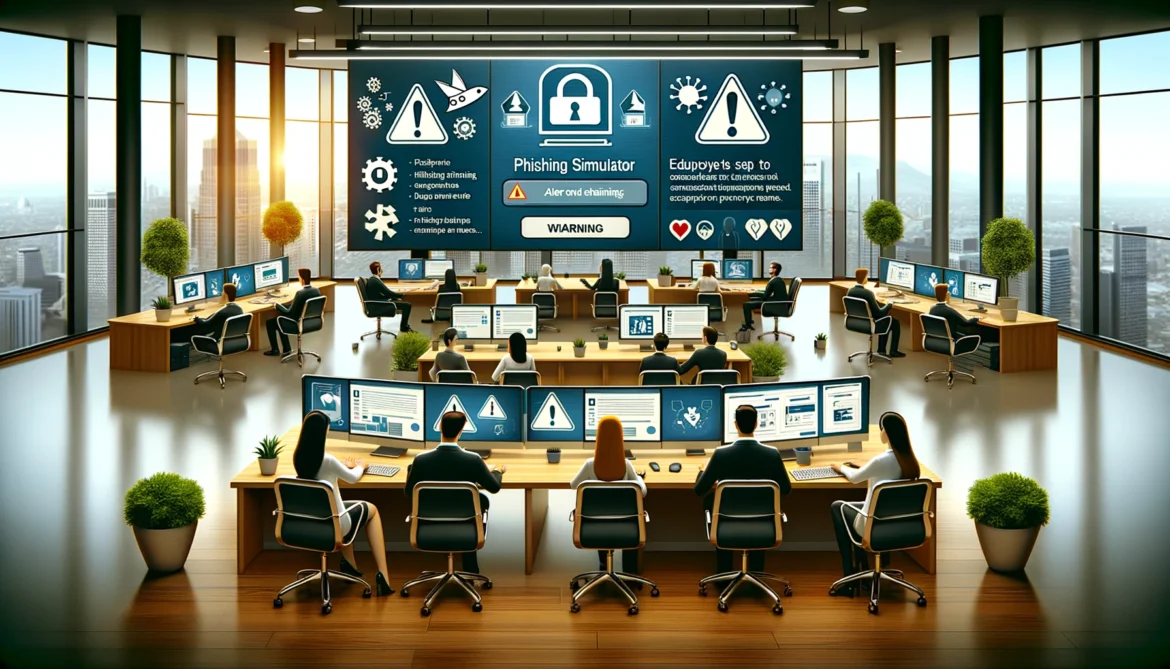Table of Contents
In the modern era, safeguarding data has become a top priority for companies across various sectors and sizes. Cyber threats and phishing attacks pose a risk to both the integrity of organizations and the trust of their customers. To effectively tackle this evolving threat landscape, it is crucial for businesses to focus on training their employees to be vigilant in recognizing and preventing phishing attempts. One valuable tool that can assist in achieving this goal is a phishing simulator. This article will delve into why incorporating a phishing simulator is essential as part of a company’s cybersecurity strategy.
The Rise of Phishing Attacks:
As technology continues to play a key role in our daily lives, cybercriminals have intensified their efforts to exploit human vulnerabilities through the use of phishing attacks. By impersonating entities via email or other communication platforms, these malicious actors aim to trick individuals into sharing sensitive information or unknowingly installing malware on personal or corporate devices.
Conventional training approaches do not adequately equip employees to combat the tactics employed by cybercriminals. Static and outdated slide presentations lack engagement and may not resonate with employees who require hands-on experience in identifying and responding to potential threats effectively. This is where a phishing simulator for employees can help.
Replicating Real Life Situations:
Introducing a phishing simulation tool allows employees to engage in practical exercises that closely resemble real-world scenarios. The simulator creates emails that imitate phishing tactics such as suspicious URLs, requests for personal login details, malicious attachments, and urgent messages that demand quick responses. By exposing employees to simulated attacks of varying complexities, organizations cultivate a culture of awareness in identifying signs associated with potential online threats. This hands-on learning approach helps staff members develop expertise in distinguishing between useful emails and harmful ones, equipping them to respond promptly when faced with such risks.
Advantages of Utilizing a Phishing Simulation Tool:
The key benefits of phishing simulation tools are:
- Risk Reduction: Implementing a phishing simulation tool lowers the chances of phishing attacks by enhancing the organization’s overall security readiness. Employees improve their ability to detect and counter threats before they can cause damage.
- Time and Cost-Effectiveness: A phishing simulation tool provides a cost-effective training solution compared to methods involving external trainers, workshops, seminars, or online courses for employees. By integrating training into work routines, businesses optimize time efficiency while ensuring learning opportunities for all staff members.
- Real-Time Analysis: By utilizing a phishing simulator, organizations can gather insights into employee behavior during attacks. These insights help decision-makers identify areas of improvement, pinpoint vulnerabilities, and customize training programs to enhance overall cybersecurity preparedness.
- Tailored Solutions: Phishing simulators offer businesses the flexibility to create customized scenarios based on industry needs or vulnerabilities identified through risk assessments. This adaptability enables training experiences that align with the organization’s objectives.
Effective Implementation Strategies:
- Emphasize Cybersecurity Importance: Start by communicating the significance of cybersecurity awareness to all employees and emphasize their role in protecting business data.
- Phased Implementation: Rolling out phishing simulations department by department allows for consistent efforts in educating personnel based on their roles and responsibilities.
- Define Performance Metrics: Set targets for employees related to identifying phishing attempts, following reporting procedures, and other key cybersecurity indicators.
- Continuous Learning: Implement continuous training programs rather than one-off sessions to ensure employees’ skills remain sharp and bolster their confidence against evolving threats.
- Recognize Successes: Share success stories by highlighting when employees successfully spotted real phishing attempts. It’s a great way to motivate them and provide reinforcement.
Enhancing Phishing Simulations with AI and Machine Learning
Leveraging AI to Craft Realistic Scenarios
Explore how artificial intelligence (AI) can be utilized to generate increasingly sophisticated phishing scenarios that mimic emerging threats. This section would discuss the integration of AI technologies to analyze patterns in employee behavior and adapt phishing tests to target commonly overlooked cues, thereby increasing the training’s effectiveness.
Machine Learning for Continuous Improvement
Detail how machine learning algorithms can continuously refine the difficulty and variety of phishing simulations based on success rates and engagement metrics. This subsection would explain how adaptive learning technology can provide personalized training experiences that evolve based on individual and group performance trends.
Future Trends in Phishing and Cybersecurity Training
Emerging Threats and Evolving Simulations
Discuss future challenges and potential developments in phishing techniques that could impact businesses. This section would speculate on how phishing simulations must evolve to keep pace with new types of cyber threats, including sophisticated spear phishing and social engineering tactics.
Integrating Phishing Training into Broader Cybersecurity Initiatives
Explore the integration of phishing simulations within a comprehensive cybersecurity education framework. This would include discussions on blending traditional cybersecurity training modules with hands-on phishing simulations, creating a robust, multi-faceted training program that addresses multiple aspects of organizational security.
Conclusion: Strengthening Organizational Resilience Through Continuous Learning
Reinforcing the Importance of Regular Training
Emphasize the necessity of regular and updated training to cope with the dynamic nature of cybersecurity threats. This concluding section would advocate for ongoing education and regular updates to training protocols to ensure they remain effective against the latest phishing techniques.
Calling for a Proactive Security Posture
End with a call to action for businesses to adopt a proactive approach to cybersecurity, highlighting how continuous improvement and adaptation in training can fortify an organization’s defenses against not only phishing but a broad spectrum of cyber threats.
These proposed sections aim to provide a comprehensive expansion of the original article, adding depth to the discussion of phishing simulations while offering practical insights and forward-looking perspectives.
Phishing attacks are a major challenge for companies globally, putting sensitive data at risk and disrupting business operations. By integrating a phishing simulation tool into an organization’s cybersecurity plan, employees can gain the knowledge and skills needed to safeguard information effectively. Through hands-on training initiatives, leaders can take advantage of the benefits offered by a phishing simulator, such as reducing risks, cost-effectiveness, real-time insights, and customization options. This approach helps nurture a holistic security environment within teams and enhances cyber resilience against evolving threats.









